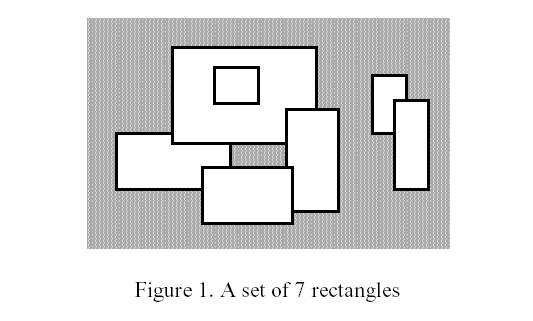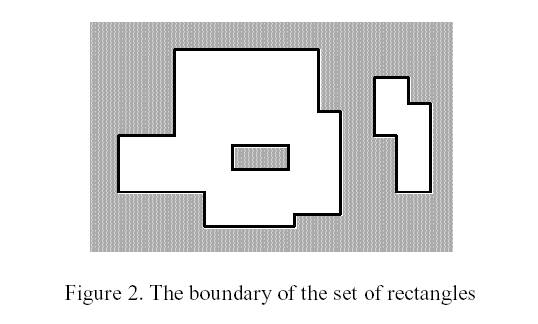hdu1828 Picture(线段树+离散化+扫描线)两种方法
来源:互联网 发布:钢琴入门自学软件 编辑:程序博客网 时间:2024/05/21 17:03
C - Picture
Time Limit:2000MS Memory Limit:10000KB 64bit IO Format:%I64d & %I64uDescription
A number of rectangular posters, photographs and other pictures of the same shape are pasted on a wall. Their sides are all vertical or horizontal. Each rectangle can be partially or totally covered by the others. The length of the boundary of the union of all rectangles is called the perimeter.
Write a program to calculate the perimeter. An example with 7 rectangles is shown in Figure 1.

The corresponding boundary is the whole set of line segments drawn in Figure 2.

The vertices of all rectangles have integer coordinates.
Write a program to calculate the perimeter. An example with 7 rectangles is shown in Figure 1.

The corresponding boundary is the whole set of line segments drawn in Figure 2.

The vertices of all rectangles have integer coordinates.
Input
Your program is to read from standard input. The first line contains the number of rectangles pasted on the wall. In each of the subsequent lines, one can find the integer coordinates of the lower left vertex and the upper right vertex of each rectangle. The values of those coordinates are given as ordered pairs consisting of an x-coordinate followed by a y-coordinate.
0 <= number of rectangles < 5000
All coordinates are in the range [-10000,10000] and any existing rectangle has a positive area.
0 <= number of rectangles < 5000
All coordinates are in the range [-10000,10000] and any existing rectangle has a positive area.
Output
Your program is to write to standard output. The output must contain a single line with a non-negative integer which corresponds to the perimeter for the input rectangles.
Sample Input
7-15 0 5 10-5 8 20 2515 -4 24 140 -6 16 42 15 10 2230 10 36 2034 0 40 16
Sample Output
228
第一种,对横向纵向分别遍历,用两次扫描线,第一次从左到右,离散化y坐标,增加一条边后,引起总和改变,改变量就是边的长度,没改变的就是隐藏在了原来图形的里面,没有形成新的边,先把所有纵向的边总计,在统计横向的边,最后的结果就是总的边长。也可以避免求图形内部的边。
#include <cstdio>#include <cstring>#include <cmath>#include <algorithm>using namespace std;#define maxn 11000struct node{int l , r ;int sum ;}cl[maxn<<2];struct node1{int k , l , r ;int flag ;}p[maxn] , q[maxn];int lazy[maxn<<2] , x[maxn] , y[maxn] ;bool cmp(node1 a,node1 b){ return a.k < b.k ;}void push_up(int rt){ if( lazy[rt] ) cl[rt].sum = cl[rt].r - cl[rt].l ; else cl[rt].sum = cl[rt<<1].sum + cl[rt<<1|1].sum ;}void creat(int rt,int l,int r,int *a){ cl[rt].l = a[l] ; cl[rt].r = a[r] ; if( r - l > 1 ) { creat(rt<<1,l,(l+r)>>1,a); creat(rt<<1|1,(l+r)>>1,r,a); push_up(rt); } else cl[rt].sum = 0 ; return ;}void update(int rt,int l,int r,int flag){ if( cl[rt].l == l && cl[rt].r == r ) { lazy[rt] += flag ; push_up(rt); } else { if( cl[rt<<1].r > l ){ int x = min(cl[rt<<1].r,r) ; update(rt<<1,l,x,flag);} if( cl[rt<<1|1].l < r ){ int x = max(cl[rt<<1|1].l,l) ; update(rt<<1|1,x,r,flag);} push_up(rt); }}int main(){int i , j , n , m , x1 , y1 , x2 , y2 , low , ans ;while(scanf("%d", &n)!=EOF){for(i = 0 ; i < n ; i++){scanf("%d %d %d %d", &x1, &y1, &x2, &y2);p[i].k = x1 ;p[i].l = y1 ;p[i].r = y2 ;p[i].flag = 1 ;p[i+n].k = x2 ;p[i+n].l = y1 ;p[i+n].r = y2 ;p[i+n].flag = -1 ;y[i+1] = y1 ;y[i+n+1] = y2 ;q[i].k = y1 ;q[i].l = x1 ;q[i].r = x2 ;q[i].flag = 1 ;q[i+n].k = y2 ;q[i+n].l = x1 ;q[i+n].r = x2 ;q[i+n].flag = -1 ;x[i+1] = x1 ;x[i+n+1] = x2 ;}ans = 0 ;memset(lazy,0,sizeof(lazy));sort(y+1,y+(2*n+1));sort(p,p+2*n,cmp);m = unique(y+1,y+(2*n+1))- (y+1);creat(1,1,m,y);ans = low = 0 ;update(1,p[0].l,p[0].r,p[0].flag);ans += fabs(low-cl[1].sum);low = cl[1].sum ;for(i = 1 ; i < 2*n ; i++) { update(1,p[i].l,p[i].r,p[i].flag); ans += fabs(low - cl[1].sum); low = cl[1].sum ; } sort(q,q+2*n,cmp); sort(x+1,x+(2*n+1)); m = unique(x+1,x+(2*n+1))-(x+1); memset(lazy,0,sizeof(lazy)); memset(cl,0,sizeof(cl)); creat(1,1,m,x); low = 0 ; update(1,q[0].l,q[0].r,q[0].flag); ans += fabs(low-cl[1].sum); low= cl[1].sum ; for(i = 1 ; i < 2*n ; i++) { update(1,q[i].l,q[i].r,q[i].flag); ans += fabs( low - cl[1].sum ); low = cl[1].sum ; } printf("%d\n", ans);}return 0;}第二种。第一种用了两次扫描线比较麻烦,也可以只用一次扫描线,离散y坐标,按x从左到右扫描,统计每次总和的更改值,这样可以得到所有纵向边的和,对于横向边,可以用(p[i].k - p[i-1].k)*cl[1].num*2.前面的(p[i].k - p[i-1].k)相邻的两条线段的x坐标的差,cl[1].num代表此时在线段树中一共有几条线段,每一条线段,就会增加这条线段的两个端点带来的横边。所以只要统计到当时有多少段覆盖的边,就可以得到那一段的横向的增加值
统计某一时刻有多少线段覆盖,可以用lp , rp记录这一个节点的两个端点是不是已经覆盖,如果覆盖值为1,那么这一段的num就是1,合并两个节点的时候,父节点的num等于左右子节点的num和,如果左节点的rp与右节点的lp都是1,那么父节点的num值减去1。最后得到统计整个线段是由几个线段组成。
#include <cstdio>#include <cstring>#include <cmath>#include <algorithm>using namespace std;#define maxn 11000struct node{ int k , l , r , flag ;} p[maxn];struct node1{ int l , r , lp , rp ; int sum , num ;} cl[maxn<<2];int lazy[maxn<<2] , s[maxn] ;bool cmp(node a,node b){ return a.k < b.k ;}void push_up(int rt){ if( lazy[rt] ) { cl[rt].lp = cl[rt].rp = 1 ; cl[rt].num = 1 ; cl[rt].sum = cl[rt].r - cl[rt].l ; } else { cl[rt].sum = cl[rt<<1].sum + cl[rt<<1|1].sum ; cl[rt].num = cl[rt<<1].num + cl[rt<<1|1].num ; cl[rt].lp = cl[rt<<1].lp ; cl[rt].rp = cl[rt<<1|1].rp ; if( cl[rt<<1].rp && cl[rt<<1|1].lp ) cl[rt].num-- ; }}void creat(int rt,int l,int r){ cl[rt].l = s[l] ; cl[rt].r = s[r] ; cl[rt].lp = cl[rt].rp = 0 ; if( r - l > 1 ) { creat(rt<<1,l,(l+r)/2); creat(rt<<1|1,(l+r)/2,r); push_up(rt); } else cl[rt].num = cl[rt].sum = 0 ;}void update(int rt,int l,int r,int flag){ if( cl[rt].l == l && cl[rt].r == r ) { lazy[rt] += flag ; push_up(rt); } else { if( cl[rt<<1].r > l ){ int x = min(r,cl[rt<<1].r) ; update(rt<<1,l,x,flag);} if( cl[rt<<1|1].l < r ){ int x = max(l,cl[rt<<1|1].l) ; update(rt<<1|1,x,r,flag);} push_up(rt); } return ;}int main(){ int n , m , i , j , x1 , y1 , x2 , y2 , ans , low ; while(scanf("%d", &n)!=EOF) { for(i = 0 ; i < n ; i++) { scanf("%d %d %d %d", &x1, &y1, &x2, &y2); p[i].k = x1 ; p[i].l = y1 ; p[i].r = y2 ;p[i].flag = 1 ; p[i+n].k = x2 ;p[i+n].l = y1 ; p[i+n].r = y2 ; p[i+n].flag = -1 ; s[i+1] = y1 ; s[i+n+1] = y2 ; } sort(s+1,s+(2*n+1)); sort(p,p+2*n,cmp); m = unique(s+1,s+(2*n+1))-(s+1) ; memset(lazy,0,sizeof(lazy)); creat(1,1,m); ans = 0 ; low = 0 ; update(1,p[0].l,p[0].r,p[0].flag); ans += fabs( low - cl[1].sum ); low = cl[1].sum ; for(i = 1 ; i < 2*n ; i++) { ans += ( p[i].k - p[i-1].k )*cl[1].num*2 ; update(1,p[i].l,p[i].r,p[i].flag); ans += fabs( low - cl[1].sum ); low = cl[1].sum ; } printf("%d\n", ans); } return 0;} 0 0
- hdu1828 Picture(线段树+离散化+扫描线)两种方法
- Picture(hdu1828,求周长并,线段树+离散化+扫描)
- hdu1828 Picture(扫描线+矩形周长并+线段树)
- hdu1828 Picture (线段树+扫描线)(求周长并)
- HDU1828 Picture(线段树+扫描线求周长并)
- POJ 1177&&HDU1828 Picture 线段树+扫描线
- hdu1828-Picture 线段树+扫描线 求周长并
- hdu1828 Picture(线段树+扫描线+矩形周长并)
- hdu1828 Picture 扫描线
- 线段树 hdu1828 Picture
- poj 1177 Picture 线段树+离散化+线扫描
- POJ 1177 Picture (线段树+离散化+扫描线) 详解
- picture 1177 poj 线段树+扫描线+离散化
- poj1177 Picture 扫描线+线段树+离散化
- POJ 1177 Picture [离散化+扫描线+线段树]
- poj1177 Picture 线段树+扫描线+离散化
- HDU 1828 Picture (线段树+扫描线+离散化)
- POJ 1177-Picture(线段树+离散化+扫描线)
- hdoj 1863 畅通工程 【最小生成树】+【kruskal】
- poj 1797 Heavy Transportation
- CodeForces 370A Rook, Bishop and King(车,象,王到目的地的最小步数)
- EditText功能总结(2)
- Memory Management Policy
- hdu1828 Picture(线段树+离散化+扫描线)两种方法
- (三分法)Light Bulb
- Mac OSX 增删磁盘分区
- 【hdu4941】hash解决大行列交换问题~
- bnuoj 36905 Nested Segments
- ubuntu无线网卡驱动问题解决方法
- 基于SDL的SDL_mixer音乐播放器
- uva--10673
- C#中File类总结


